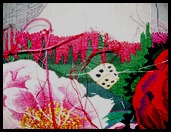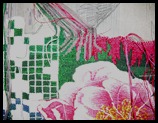The pointy things always cause the problems
and the point is at the end of this blog
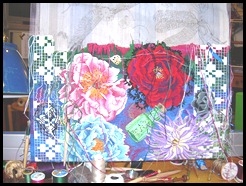 It’s amazing how much one can stuff into 2 weeks. I am little further along with my tapestry. No excuses for the amount of weaving done. I am having a great time. I am delighted with the fact that I was able to weave 2-6 hours a day for most of the last two weeks. I am still on schedule for finishing by the middle to end of July. I still had time to work a little on finishing all-not all-some-there are many more to go- the small jobs in the remodel, get my new herb beds up and running, plus fill the other 3. We used 6 yards of compost gardening soil to fill them.The beds are taller then average by 4-6 inches.The path between the two beds I redid to make it safer and wider for things like scooters and friends and students that have trouble walking and seeing. My metal gate with rays is finally hanging and being used. It will soon be turquoise. I wanted Spencer to be able to garden in them easily without having to bend over too much.
It’s amazing how much one can stuff into 2 weeks. I am little further along with my tapestry. No excuses for the amount of weaving done. I am having a great time. I am delighted with the fact that I was able to weave 2-6 hours a day for most of the last two weeks. I am still on schedule for finishing by the middle to end of July. I still had time to work a little on finishing all-not all-some-there are many more to go- the small jobs in the remodel, get my new herb beds up and running, plus fill the other 3. We used 6 yards of compost gardening soil to fill them.The beds are taller then average by 4-6 inches.The path between the two beds I redid to make it safer and wider for things like scooters and friends and students that have trouble walking and seeing. My metal gate with rays is finally hanging and being used. It will soon be turquoise. I wanted Spencer to be able to garden in them easily without having to bend over too much.
One of my goals is to plant herb gardens with the dye plants that were used in medieval tapestries both for dyeing and symbolism. Not to actually dye with, but to be able to photograph and incorporate some of the pictures into tapestries-just for fun as a footnote to the long history of tapestry. Can hardly wait until I find an acanthus like woven in the Verdures.
tapestries-just for fun as a footnote to the long history of tapestry. Can hardly wait until I find an acanthus like woven in the Verdures.
My other goal is to grow the fresh herbs I love to cook with. I set up my first not so perfect herb garden at my grandmother’s when I was about 8 and now I am 64. I love cooking with fresh herbs. Actually, I love to go out and smell the herbs. Spencer comes from a slightly different view he likes to grow vegetables as his father and Grandfather did. He has hills of potatoes scattered all over the yard, because it took us so long to get the new beds filled. His favourite things right now seem to be purple potatoes, limited amounts of tomatoes, onions, peppers, pumpkin for thanksgiving, and melons. Yes, we didn’t get our potatoes in by Good Friday-a Montana tradition or a Hooker family tradition… My other Gramma lived in Oregon and planted her garden as soon as she didn’t sink into the mud.
But best of all I have real flowers to work with in my tapestries.
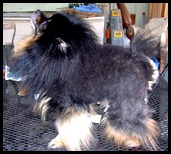 About fiber for tapestry weaving. If I were going to manufacture the fiber for tapestry weaving I think I should try using Chene’s hair. It’s a beautiful black with parts of the undercoat being grey. Poor Chene was up to 8.25 lbs-Now he weighs without the excess fur a tad under 6 lbs. He looked so miserable that I decided he needed his summer shearing. Figuring, if it didn’t warm up he could wear his sweater like he did last year. So I removed the hair from his back and tummy, tail
About fiber for tapestry weaving. If I were going to manufacture the fiber for tapestry weaving I think I should try using Chene’s hair. It’s a beautiful black with parts of the undercoat being grey. Poor Chene was up to 8.25 lbs-Now he weighs without the excess fur a tad under 6 lbs. He looked so miserable that I decided he needed his summer shearing. Figuring, if it didn’t warm up he could wear his sweater like he did last year. So I removed the hair from his back and tummy, tail leaving only his mane throat and leg banners. Some of the fur was 7-8 inches long. It took hours to do it because my electric clippers kept over heating in the density of his under coat.
leaving only his mane throat and leg banners. Some of the fur was 7-8 inches long. It took hours to do it because my electric clippers kept over heating in the density of his under coat.
My Dad came for a week.
We are trying to get the days closer together and the stay lengths longer. In some ways I felt bad. He wanted to see what I was doing in the studio. But, I weave on a second floor with steep steps. Not somet hing he could easily negotiate. So everyday. I would show him the snap that I take everyday that I weave. Not quite the same thing, but it was better then nothing. He was fascinated with some of the early animations that I did of earlier tapestries- a picture each day, set into a slide show. It takes around a minute from start to finish. I have been trying to figure out how to put them on this blog, but haven’t yet. I am still trying to figure out how to attach the U-Tube videos of the care and feeding of bobbins to this blog.
hing he could easily negotiate. So everyday. I would show him the snap that I take everyday that I weave. Not quite the same thing, but it was better then nothing. He was fascinated with some of the early animations that I did of earlier tapestries- a picture each day, set into a slide show. It takes around a minute from start to finish. I have been trying to figure out how to put them on this blog, but haven’t yet. I am still trying to figure out how to attach the U-Tube videos of the care and feeding of bobbins to this blog.
The pointy things in tapestry.
What you do with the pointy thing.
I can’t quite write about this without thinking about Arya(Game of Thrones) and her problems of what to do with the pointy end. I had to do a lot of thinking about the pointed tree tops in my tapestry.
In tapestry points can go in two directions across the weft or up the weft. There are eccentric variations that can turn points to angle up hills and down valleys. Example the tops of the trees and the grey beginnings of the bird wing in my this tapestry.
At 10 to the inch it’s fairly easy to make points look right because people often stand back away from the tapestry to get it full effect and maximum optical blending of colour and technique-optimum distances is usually 10 feet for 10 epi. %feet for small format. And, the points almost always look pointy from a distance. Small format is a little more difficult-not technically, but visually more challenging because people stand so close to the image-usuall within a foot or two. People stand very close to small format/small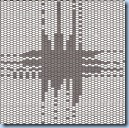 scale tapestries instead of a theoretical 5 foot optimum.
scale tapestries instead of a theoretical 5 foot optimum.
The pointy end is the hardest-dare I say sharpest point to make look neat at that close of a distance.
There are things you can do to make the points stay in place. One can do a wrap and carefully share the warp next to the point
 Instead of moving on up as in the diagram. I would do a pigtail on the wrapped warp to stabilize the tip after I doing the share warp Instead of moving on up as in the diagram. I would do a pigtail on the wrapped warp to stabilize the tip after I doing the share warp |
with the two passes it goes between covering the extra weft join as the two passes are squished together. One could do a double weft interlock on either side of the one weft  point. If it is
point. If it is ![]() especially long- one could do a series of cavendoli knots. Then making doubly sure they are untwisted and stitch through the ridge to keep it to the back. One could do a tall wrap and then pig tail it off below on the first shoulder of the point. The other trick is to end the point in such
especially long- one could do a series of cavendoli knots. Then making doubly sure they are untwisted and stitch through the ridge to keep it to the back. One could do a tall wrap and then pig tail it off below on the first shoulder of the point. The other trick is to end the point in such away that the next pass has an open warp thread. that goes across it the first time one weaves over it. The opposite of this also works if you want a lower point-begin it on an open warp if possible so that the beginning of the point sinks into a hollow thread.
away that the next pass has an open warp thread. that goes across it the first time one weaves over it. The opposite of this also works if you want a lower point-begin it on an open warp if possible so that the beginning of the point sinks into a hollow thread.
The two obvious details of fat spiders and the directional use of hatches, hachures are from the Lady and the Unicorn—smell and touch-not something wove even in another life time. They are very good examples of the inherent problems and solutions to/in dealing with pointy things in tapestry. I have spent years studying them to come up with the fat spiders and skinny spiders that are described in the Line and tapestry book I wrote. Also notice that there are examples of eccentrically woven pointy things and hatches in the sense of smell.
The diagrams of technique were obviously done by Pat Spark as she illustrated the Line in Tapestry book.
Anyway, that’s some of the things to do with the pointy ends in tapestry.
Cheers and all,
kathe
